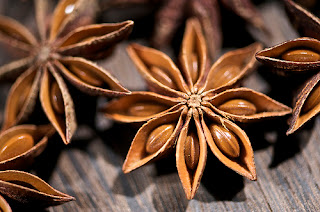from
Behind the French Menu
by
Bryan G. Newman
behindthefrenchmenu@gmail.com
Dried star anise
https://www.flickr.com/photos/geishaboy500/4297746909/
Anis Étoile, Badiane or La Badiane Chinoise - Star Anise; the star-shaped fruit of the Chinese Anis plant. Star Anise has been used in Chinese and other Asian cuisines for thousands of years for its aniseed flavor. In the West, the most popular herb used for its aniseed flavor was Aniseed, Anis or Boucage in French. The oil of the star anise is fragrant and is used in Asian cooking, as well as being employed in perfumes and soaps. Star Anis is also the most essential ingredient in that important Chinese spice group the Cinq Épices Chinois, the Chinese five spice powder; today, however, the Chinese five spice powder often has the Western Anis included, alongside star anise, as it allows for a more mellow flavor and Chinese tastes have changed.
Star Anise and Western cooking.
Two hundred years ago star anise came into mainstream European cuisine competing with and adding to Anis and other herbs for the best aniseed flavor. Beginning with Absinthe Star Anis became famous in France’s and other country’s aniseed flavored drinks. Star anise along with aniseed is an essential ingredient in France’s popular Pastis and similar alcoholic drinks.
The Star Anise fruits.
Star Anise comes from a tropical evergreen tree that may grow up to 10 meters (33 feet) in height. The fruit of the tree is the star shaped pods that give the star anise its name; inside each pod is a pea-sized fruit that is also part of the spice.The star shaped fruits (pods) are always used in a dried state, they are harvested before they are fully ripe and then allowed to dry to their signature brown color
The Star Anise plant and fruit.
https://www.flickr.com/photos/biodivlibrary/8231725093/
Star Anise on French Menus:
Le Filet De Sandre Des Bateliers à l’Anis Étoilé et Duxelles de Champignons - A filet of pike-perch (also called Zander) caught by fishermen and women on boats on the River Loire flavored with star anise and served with mushroom duxelles.
Star Anise drying on the tree.
Gigot d'Agneau à l'Orange et à l'Anis Étoilé - Leg of lamb flavored with orange and star anise,
Navarin d'Agneau à l'Anis Étoilé – A Navarin, a traditional lamb and turnip stew flavored with Star Anise.
Star Anise reading for picking and drying
Le Médaillon de Cochon de Lait Basse Température, Jus Corsé à l'Anis Étoilé, Écrasé De Pommes De Terre À La Ciboulette – A medallion, a round or oval cut, from a suckling pig that has been very slowly cooked at a low temperature. The medallion cut is served with a jus course, the natural cooking juices, flavored with star anise and the dish is accompanied by hand mashed potatoes flavored with chives.
Braised pork belly flavored with star anise.
Served with poached egg and pickled mustard greens over ginger jasmine rice
https://www.flickr.com/photos/saucesupreme/14889007295/
Saint-Jacques Fumées à l'Anis Étoilé – King Scallops smoked with and flavored with star anise.
Saumon Confit Dans un Bouillon de Gingembre et Anis Étoilé – Salmon slowly cooked in a bouillon of ginger and star anise
Warnings on star anise teas.
N. B. In September 2003, the U.S. Food and Drug Administration advised against drinking star anise teas (fusions or tisanes). The FDA warned consumers not to consume fusions/ teas containing star anise as it has been associated with neurological problems including vomiting, rapid eye movements and more. Despite this, no such problems have been reported from the use of star anise in cooking or in Pastis and similar alcoholic drinks that contain star anise. Since that 2003 warning, I can find no further updates.
Star anise and the flu.
Star Anise hit the news when it became a major component in Tamiflu, (Oseltamivir). Tamiflu is, at this time, the only successful antiviral medication that blocks the actions of influenza virus types A and B. Originally, the major active ingredient was star anise; that discovery sent the price of star anise to the stars in the outer galaxies. Then, luckily for those who enjoy star anise in cooking or in alcoholic drinks the active anti-flu ingredient in star anise was created in the laboratory and the price of the spice returned to earth.
The star anise essential oil
(Catalan - anís estelat ), (Dutch - steranijs), (German – sternanis, badian), (Italian - anice stellato, badiana), (Spanish - badián, badiana, anís estrella),
Connected Posts:
Behind the French Menu
by
Bryan G. Newman
behindthefrenchmenu@gmail.com
Copyright 2010, 2017





















